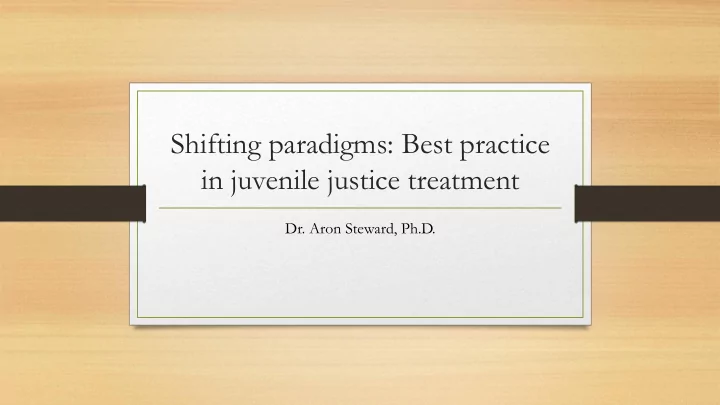

Shifting paradigms: Best practice in juvenile justice treatment Dr. Aron Steward, Ph.D.
Overview • Historical Overview • Paradigm shift • Physical intervention/Isolation • Current best practice trends • Prison pipeline • Future implications
Historical Overview
Long before…. • 1760’s “ Commentaries on the Laws of England” William Blackstone, English lawyer • Defined anyone under the age of 7, unable to commit a crime • Based on 2 part determinant, intent and unlawful act • Age 7-14, dependent on whether the child knew right from wrong • Over 14, tried as an adult • Sentencing could be as serious as death • ABA, Division of Public Education, “The History of Juvenile Justice”
19 th Century United States • Paradigm shift – juveniles need reform to help them become better citizens • Reform schools, Rehabilitation • 1825 – NYC - Society for the Prevention of Juvenile Delinquency, New York House of Refuge • 1855 – Chicago – The Chicago Reform School • Alternative Programing • Probation, Group homes, out of home placement • Court systems/sentencing • 1899 – Cook County, Illinois – the first juvenile court system • Over the next 25 years all other states established a juvenile court system • ABA, Division of Public Education, “The History of Juvenile Justice”
20 th Century • 1967 – All juvenile cases were afforded due process • Notice of the charges against them • A right to legal counsel • The right against self-incrimination • The right to confront and cross-examine witnesses • 1970 – Established that juvenile cases must establish a “preponderance of evidence” not “beyond a reasonable doubt” (Criminal court) • 1971 - McKeiver v. Pennsylvania, Court ruled that juveniles are not entitled to trial by jury • ABA, Division of Public Education, “The History of Juvenile Justice”
Paradigm Shifts
1980’s/1990’s Fear • Increase in violent crime • Increase in juvenile offenses • First incidence of mass shooting • Highly publicized juvenile crimes
Response • Increase in arrests • Increase in sentencing • Increase in status offenses in court • Increase in placement in facilities • Increase in high level interventions
Last 5/10 years • Research does not find the harsher sentences, longer time in facilities, stricter policies to have reduced crime • Juvenile crime decreasing • Research finds that high level interventions to be ineffective and even detrimental to the adolescent brain • Anecdotes suggest alternative programming, therapies, solutions to be effective
Response • States are shifting from “incarcerating” juveniles to providing them best practices psychiatric treatment • High level interventions are starting to be monitored and scrutinized by government entities and regulatory parties • There is a larger emphasis placed on keeping youth in their communities under supervision • Restorative and social justice are being utilized
Physical Intervention/Isolation/Seclusion
Definitions Kraus & Arroyo (2005) • Seclusion • Isolation • Restraint • Chemical • Physical
Contraindications • The adolescent brain development and impact • Short lived change without internal achievement • Addiction • Secondary gain • Decreased trust in authority and systems • Increased risk for suicide, self-harm, mental illness
Prison Pipeline
1990’s Curtis (2014) • Zero tolerance polices • Implemented to reduce drug possession and guns • Used in response to bullying, school threats, weapons, drugs, alchol, fights • Referring disciplinary offenses to law enforcement • School resource officers
• Harsh discipline responses to school behavior • Increased referral to law enforcement • More rapid suspension/expulsion • Faster referral to alternative education • Less services • Disproportionate ethnic minority status • Curtis (2014)
• Impact of being out of school • Impact of being incarcerated • Impact of education in facilities • Impact of being out of the community of origin
Current best practice
Trauma informed services • Treating the amygdala and limbic system before treating behavior • Treating youth who have trauma histories with caution • Organizing the system in a trauma informed manner for trickle down • Each youth is an individual and also their own expert • Youth learn best when safe and calm
Positive Peer Culture • Adolescents learn from one another faster than adults • Social/milieu dysfunction slows treatment • A positive environment in treatment avoids pathologizing survival behaviors • Inclusionary • Increases the opportunity for higher level skill building like leadership, cohesion, social justice
Prevention not intervention • Diversion • Restorative justice/social justice for first offenses • Early identification and adequate diagnosis • Breaking behavioral patterns early • Physical intervention and isolation does not work and can be traumatizing
Family involvement • Juveniles often return to family • Family values and early lessons dictate beliefs • Family knows the historical perspective • Healing the family unit increases transitional success • Families can help leverage treatment
From manuals to relationships • Safety heals attachment • Structure mends trauma • Relationships develop trust • Care and love support self-esteem and empowerment • An ally increases motivation
Integrated and holistic services • Treating the whole youth • Multidisciplinary teams • Bringing the community in and the youth out • Focus on wellness not on recidivism • Youth driven
Alternative therapies • Music therapy • Psychodrama • Bibliotherapy • Art therapy • Animal therapy • Recreation and movement therapy
Future implications
What can we do? • Know the facts • Understand the adolescent brain • Utilize what works • Work harder on the front end • Mentoring • Commit to ending incarceration as a business • Donate time, money, resources, or yourself
References • “The History of Juvenile Justice,” The American Bar Association, Division for Public Education, Chapter 1 • Curtis, Aaron. (2014). Tracing the School to Prison Pipeline from zero tolerance policies to juvenile justice dispositions. The Georgetown Law Journal, Vol. 102 pp 1251-1277 • Kraus, L., & Arroyo, W . (2005) Recommendations for Juvenile Justice Reform, Second Edition, American Academy of Child and Adolescent Psychiatry Committee on Juvenile Justice Reform
Questions/Comments Thank you!
Recommend
More recommend